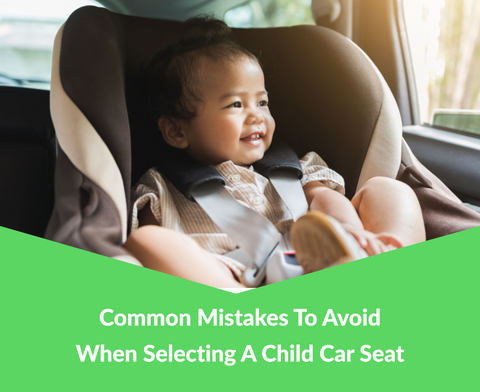
9 Common Mistakes To Avoid When Selecting A Child Car Seat

Car safety is an essential aspect of parenting, and choosing the right car seat for your child can be a daunting task.
With so many options available in the market, it's easy to get overwhelmed and make mistakes that can put your child's safety at risk.
In this article, we will discuss the common mistakes parents make when selecting a child car seat and how to avoid them.
1. Not Considering the Age and Size of Your Child
One of the most common mistakes parents make when selecting a car seat is not considering the age and size of their child.
There are different types of car seats available, and each is designed for a specific age and weight range.
Using the wrong car seat can be dangerous and reduce the effectiveness of the safety features.
2. Choosing the Wrong Type of Car Seat
Choosing the wrong type of car seat is another common mistake. Infant car seats, convertible car seats, and booster seats all serve different purposes and are designed for different age ranges.
It's crucial to understand the features and limitations of each type of car seat and select the one that is appropriate for your child's age, weight, and height.
3. Not Checking for Safety Certifications
All car seats sold in the UK must meet safety standards set by the European Union.
Look for the 'E' mark, which ensures that the car seat has undergone rigorous testing and meets the required safety standards. Additionally, some car seats have additional safety certifications, such as the ADAC seal, which indicates that the seat has passed additional tests for safety and user-friendliness.
4. Overlooking the Installation Process
Installing a car seat correctly is crucial for your child's safety. However, many parents overlook this step and assume that it's a straightforward process.
It's essential to read the manufacturer's instructions carefully and ensure that the car seat is installed correctly in your vehicle.
You can also seek help from a certified car seat technician to check the installation and ensure that the seat is secure.
5. Failing to Secure the Harness Straps Correctly
The harness straps of a car seat play a crucial role in protecting your child in an accident.
It's essential to ensure that the straps are snug and secure, with no slack or twists.
The chest clip should be at armpit level, and the harness should be tight enough that you can't pinch any excess material. Additionally, avoid dressing your child in bulky clothing that can interfere with the harness's effectiveness.
6. Not Adjusting the Seat as Your Child Grows
Your child will grow and develop quickly, and it's crucial to adjust the car seat accordingly.
As your child gets taller, the straps will need to be adjusted to fit snugly. Many car seats have adjustable features, such as a headrest, to accommodate your child's growth.
It's important to check the car seat's manual and adjust it according to the manufacturer's recommendations.
7. Using a Second-Hand Car Seat Without Proper Inspection
Using a second-hand car seat can save you money, but it can also be risky.
You don't know the car seat's history, and it may have been in an accident or have hidden damage that can compromise its safety.
If you decide to use a second-hand car seat, ensure that it meets current safety standards and has not been recalled. Additionally, inspect the car seat thoroughly for any visible signs of damage, such as cracks or missing parts.
8. Ignoring Recall Notices
Car seats can be recalled for safety reasons, and it's crucial to stay up-to-date with the latest recalls.
Check the manufacturer's website or the government's product recall website to see if your car seat has been recalled.
If it has, stop using it immediately and follow the manufacturer's instructions for repair or replacement.
9. Not Replacing the Car Seat After an Accident
If your car is involved in an accident, it's important to replace the car seat, even if there are no visible signs of damage.
The car seat may have hidden damage that can compromise its effectiveness in protecting your child.
Check with your insurance provider, as many policies cover the cost of a new car seat after an accident.
In Summary
Selecting the right car seat for your child is a crucial aspect of parenting, and it's essential to avoid common mistakes that can compromise your child's safety.
Consider the age and size of your child, choose the right type of car seat, check for safety certifications, install the car seat correctly, secure the harness straps, adjust the seat as your child grows, and avoid using a second-hand car seat without proper inspection.
Stay up-to-date with the latest recalls and replace the car seat after an accident.
By following these tips, you can ensure that your child is safe and secure while traveling in a car.
FAQs
What age should a child be in a rear-facing car seat?
Children should remain in a rear-facing car seat until they are at least 15 months old.
Can I use a booster seat for my newborn?
No, booster seats are designed for older children who have outgrown their forward-facing car seat.
How often should I replace my child's car seat?
It's recommended to replace a car seat every six to eight years, or sooner if it has been in an accident or has been recalled.
Can I use a car seat on a plane?
Yes, many car seats are approved for use on airplanes. Check with the airline for their specific regulations.
How tight should the harness straps be on a car seat?
The harness straps should be snug and secure, with no slack or twists. The chest clip should be at armpit level, and the harness should be tight enough that you can't pinch any excess material.
